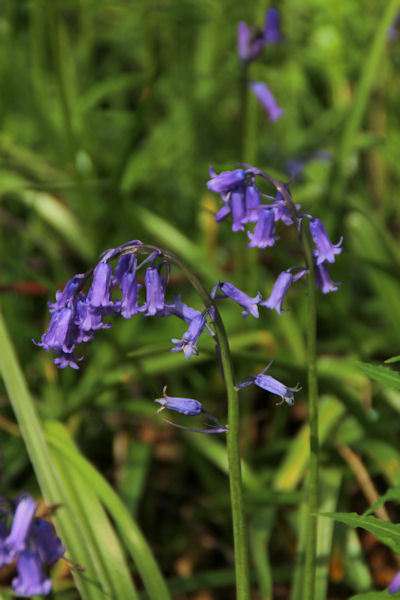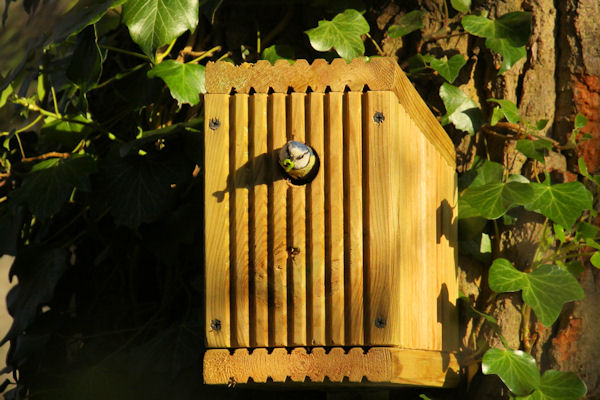May in Bicknor Wood 2021 - Part 1
May is the month of the Bluebells. There is little to compete with these few short weeks when the profusion of blue reaches spectacular proportions. May is also the month when so much is happening that a single post could not possibly do it justice. There will be 2 posts this month to try to keep up with events. It's like a soap opera in there!
The blog has received a set of photographs from Phil Riches paying homage to the Bluebells and you will find a link here when that post goes live. In the meantime, here are a couple of shots to keep you going.
The big story outside of the wildflowers is the raiding of the nest boxes by the Great Spotted Woodpeckers. Again, there is a separate post which was published on 11th May. The woodpeckers have been targeting the Wilko boxes, finding their way in to steal the chicks by chiselling away at the seam between the front boards.
11 Wilko boxes were originally put up. Of those, 7 have been attacked and 5 have been damaged beyond use. The woodpeckers have been responsible for damaging at least 9 nests this season, natural nests as well as man-made.
The woodpeckers only predate the boxes which have shown signs of nesting activity and until now, only the Wilko boxes with the join across the front. Now that they have driven nesters from all the Wilko boxes, only 2 pairs are still feeding young. These are in the more robust "Made in Bicknor" boxes, but even these are coming under attack as the woodpeckers' pickings are reduced.
As of the 14th, the Nuthatches are still feeding in their natural hole in an oak. One was seen looking very dishevelled and the other came from the hole carrying a faecal sac, confirmation of young in the nest.
A juvenile Robin was seen on the 7th May and a young, short-tailed Magpie was seen out of the nest on 10th. The Blackbird nest by the fork in the path has been quiet since the 8th.
Square-stemmed Common Figwort was seen for the first time on May 4th and Red Campions showed their first flower on 8th.
The Bluebells carpeted the woodland floor on the 12th with only a few paths trampled into them. By the 14th, a thoroughfare had been ploughed through the middle of the coppices.
Bluebells are easily damaged and do not recover quickly. Please stay on the proper paths and encourage others to do so. Thank you.
The first Speckled Wood butterfly was seen on the 10th, as was the first Orangetip and Red Admiral.
Orangetips and Red Admirals have been seen earlier in Greater Bicknor, but this were the first sightings in the wood itself.
Other insects have responded to the warmer wetter weather and these have drawn out the bats. The usual suspects, Soprano Pipistrelle, Common Pipistrelle and Noctule have been noted throughout the month with a couple of suspect recordings from the 4th May. Lesser Noctule and Barbastelle are rare and localised in England. It is more likely that the recordings are erroneous, but if anyone else has any bat-detecting equipment and also gets a hit from either of these, please let me know.
The oaks have staggered their leafing. At first it appeared that the two species would leaf in their own time, but now it appears that individual oaks, irrespective of species are setting their own agenda. This would work extremely well if we had any parent birds left seeking food for their offspring. Winter Moth and Green Tetrax lay their eggs in the buds and bark crevices of oak trees (follow this link for more on the moths). The eggs hatch to coincide with the opening of leaves and the larvae start feeding on the young fresh greens. By staggering their leafing time, oaks spread the growth of the larvae and thus the time available for parent birds to find food. The birds also try to coincide their egg hatching with the time of greatest abundance.
Early in the hatch there are many larvae. As time passes, their numbers are reduced by the marauding birds, but as they feed they become bigger, so maintaining the food availability. Hopefully it is not too late for some of our birds to try again and if the extended period of leafing has prolonged the larval development, there may still be enough food to feed hungry late broods.
Ash and Chestnut are dragging their feet with their leaves barely starting to show. Hopefully this will introduce another food source for birds making a second attempt. It is not unusual for Robins and Blackbirds to attempt 2 or even 3 broods in one year.



















Comments
Post a Comment